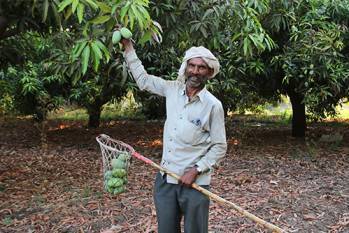MUMBAI, 8 April 2024: Maharashtra, the land of vibrant festivals and historical landmarks, also boasts a fertile landscape perfect for cultivating the "King of Fruits" - the mango. With its diverse agro-climatic zones, the state offers immense potential for establishing a thriving mango farm.
If you're considering venturing into this rewarding yet challenging field, this guide provides a roadmap to get you started, along with information on supportive government policies.
Planning Your Mango Orchard
-
Location Selection: The first crucial step is choosing the right land. Opt for well-drained, fertile soil with a pH ranging from 5.5 to 7.5. Avoid waterlogged areas and choose a location with ample sunlight, ideally receiving at least 6-8 hours daily. Consider proximity to water sources for irrigation and accessibility to transportation for easier produce movement.
-
Variety Selection: Maharashtra is home to a wide range of delectable mango varieties, each with its unique characteristics. Popular choices include Alphonso (Haapus), Kesari, Devgad Ratnagiri Alphonso (D Ratnagiri), Pairi (Langda), and Neelam. Research market demand, climatic suitability for your chosen location, and your desired harvest season before making a selection.
-
Planting Techniques: The ideal planting time for mangoes in Maharashtra falls between February and April. Utilize the square system for efficient orchard layout, ensuring adequate spacing between trees to allow for proper sunlight penetration and air circulation. Consult agricultural experts for guidance on digging pits, planting depth, and proper root ball placement.
Government Support for Mango Farmers
The Indian government, along with the Maharashtra state government, offers various schemes and initiatives to support mango farmers. Here are some key programs to be aware of:
- Mission for Integrated Development of Horticulture (MIDH): This central government scheme provides financial assistance for establishing new orchards, including subsidies for planting materials, drip irrigation systems, and protected cultivation structures.
- Subsidy on Micro Irrigation Systems: The Maharashtra government offers subsidies for installing micro-irrigation systems like drip irrigation, which helps conserve water and improve nutrient delivery to trees.
- Soil Health Card Scheme: This central government initiative provides farmers with a soil health card, offering valuable insights into soil fertility and recommendations for corrective measures.
- Mango Orchard Management:
- Irrigation: Mango trees require proper irrigation during the initial establishment phase and critical growth stages. Invest in a reliable irrigation system like drip irrigation to optimize water usage and minimize waterlogging.
- Nutrient Management: Regularly monitor soil health and apply fertilizers based on the specific needs of your mango trees. Organic manure application can be beneficial for long-term soil health.
- Pest and Disease Control: Mango trees can be susceptible to various pests and diseases. Implement integrated pest management (IPM) practices, combining biological and chemical control methods under the guidance of agricultural experts.
- Harvesting and Post-Harvest Management:
- Harvest Timing: The ideal harvest time depends on the specific mango variety. Monitor fruit maturity through visual cues like color change and firmness. Utilize proper harvesting techniques to avoid damaging the fruit.
- Post-Harvest Handling: Careful post-harvest handling practices are crucial to minimize losses and ensure longer shelf life. This includes proper sorting, grading, packing, and storage facilities.
Additional Resources and Considerations
- Connect with Krishi Vigyan Kendras (KVKs): These government-run agricultural extension centers offer valuable advice and training programs on various aspects of mango cultivation.
- Market Research: Understanding the market dynamics for your chosen mango variety is essential. Research local markets, explore potential partnerships with wholesalers or processing units, and stay updated on market trends.
- Embrace Technology: Consider adopting new technologies like precision farming techniques and weather monitoring tools to optimize resource management and improve crop yields.
Conclusion
Setting up a mango farm in Maharashtra requires careful planning, dedication, and knowledge. By following these guidelines, leveraging available government support schemes, and continuously honing your skills, you can embark on a successful journey in the world of mango farming. Remember, success hinges on a combination of strong agricultural practices, informed decision-making, and a commitment to quality. With the right approach, your mango orchard can not only be a source of income but also contribute to Maharashtra's rich tradition of fruit production.
Image credit: savanifarms.com























